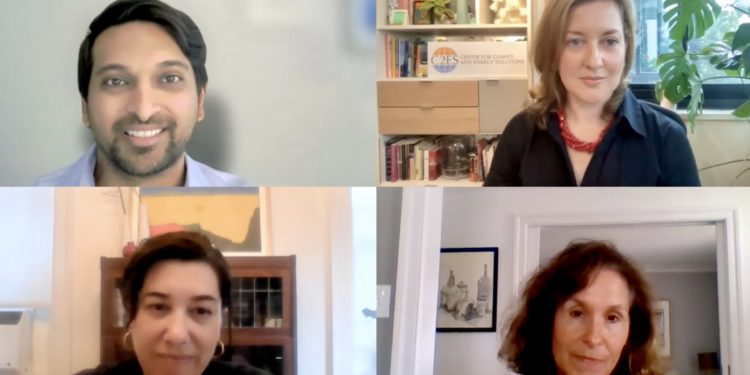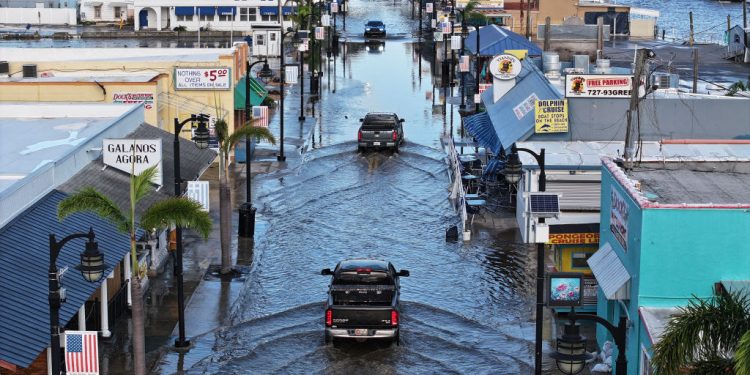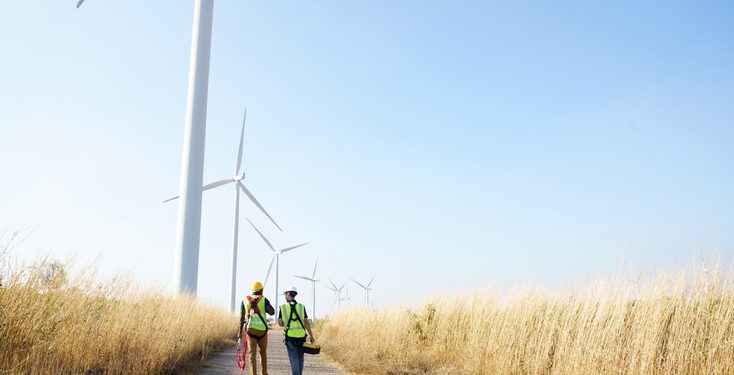A Top Corporate Sustainability Consultant Says There’s a Major Gap in Climate Policy Between ‘Leading Edge’ Companies Like Google and Microsoft and Everyone Else

(Courtesy of Andrew Winston)
When Andrew Winston joined Daniel C. Esty, an environmental policy expert teaching at Yale, to begin working on their book “Green to Gold” in 2003, there wasn’t much you could find in bookstores on how to lead sustainable companies.
“Climate change” was still years away from becoming a widely discussed topic in business, and the idea that companies could ‘go green” was still in its infancy. The book hit stores in 2006, the same year the documentary “An Inconvenient Truth” brought the debate over global warming to the masses, and its case for improving returns while reducing your organization’s negative environmental impact registered with CEOs across America.
Winston has continued that work over the past 15 years, establishing himself as one of the country’s premiere consultants on corporate sustainability, working with companies like HP, Johnson & Johnson, Marriott, PepsiCo, and Unilever. It was through his relationship with Unilever that led him to collaborate with its former visionary CEO, Paul Polman, on the upcoming sustainability guide “Net Positive,” which has more urgency and calls on companies to be far more ambitious than they were when “Green to Gold” came out.
For this year’s Climate Week – coming the month after a dire IPCC report on climate change – we spoke with Winston about the ways the field has changed since he entered it around two decades ago, and how to make sense of what feels like an unending string of climate policy announcements.
The following interview has been edited for length and clarity.
Andrew Winston: Twenty years ago, if you told me where we’d be 10 or 15 years later, I don’t know if I would have started – it would have been kind of depressing!
There’s been this kind of natural progression, but some things have changed in the last couple of years. When I started getting into this, it wasn’t like the business community was unaware of sustainability, but you can go back and look at the number of sustainability reports and goals, and it was not big.
Every company had some kind of compliance agenda, had statements about how we care about the environment, but very few use the word “climate.” There wasn’t real pressure. My book “Green to Gold” came out 15 years ago and there weren’t that many others like it. The case had to be simple – green doesn’t hurt, it saves money, it’s good for you, and it’s not some liberal trying to take over your business and be anti-business.
Now, keep in mind, I still get asked to give that talk today all the time, so there’s still a huge chunk of the business world that is still thinking, well, this is always really expensive. I think what’s evolved, though, is the leading edge, certainly. The leading edge companies are just far ahead of the average or the lagging company.
And I think what’s happened over the last five years especially is that the battle to get sustainability on the agenda for large companies is over. From that perspective, all of us in the field, we won. I’ve had my website pivotgoals.com up for eight or nine years, and we can see now that pretty much every company in the Fortune Global 500 has some form of goals on climate or energy and some form of sustainability report. The gaps there are maybe Chinese national companies that just issue statements about keeping with the government’s five-year plan.
In the last two years, I’ve seen more change in the meaning of the role of business in society than in the previous 20. That’s for many reasons – the murder of George Floyd, MeToo, inequality getting drastically worse over the last 40. All the “mega trends” that I talk about with companies are just happening. You’re not debating climate as a model anymore. It’s like, “Oh, what’s happening to my supply chain in this region is from increased storms.” It’s much more tangible.
We’re beginning the battle for thinking about the long term in a real way finally, and I’d say the biggest change in the last year has been in the financial community. Among all stakeholders, I’d have said that until recently they were laggards slowing things down. But now they’re at the table. I’m skeptical, but I’m hopeful.
JUST Capital: With the rise of ESG investing and more sustainability reports, critics often argue that greenwashing has gotten more sophisticated. They’ll point to ways that companies can say that initiatives are resonating with customers without proving any real impact on the environment. What do you think of this critique, and how do you think companies have been communicating their goals and progress?
Winston: I’ve never thought greenwashing was a huge problem – I probably define it a little more narrowly. To me, true greenwashing is doing the opposite of what you’re saying. But I think that’s pretty rare with transparency.
I think that the way it plays out often is that companies are doing something they’re proud of and they talk about it without very good context on whether it’s a big deal or not. They’re buying X amount of renewable energy, or they built a new factory with zero waste, and it often lacks the context of how we’re still losing [in the bigger picture]. The whole reason we wrote “Net Positive,” is to say it’s just not enough.
I think we’ve probably entered a phase where companies are almost surprising themselves like, oh, this is good for business. So they’re like, look, I can talk about it as brand value, I can talk about how my customers and my employees like it.
There were old ads that said things like, “We did this to our factory, and it’s the equivalent of taking 37 million cars off the road for three seconds.” I always thought, I don’t know what you’re talking about. There’s always been a challenge in how to communicate this.
It can be difficult to find that balance, but as a business, you do want to show that it’s creating business value and you shouldn’t be shying away from that. That’s something Paul [Polman] certainly embedded in me. I mean, I was already the pro-business green guy, but he got me a little further down the path to talking about how we can talk about the growth of the business in a smart way, and to also say, oh, but consumption is too high. There are these tensions that we’ve got to work on. If we think we’re just going to all use less stuff, sure, but there’s going to be another billion or two billion people that need a higher quality of life, even basic stuff, which means using more. These are complicated issues. And I find, I feel sometimes for companies trying to communicate this, because they’re nervous about being slammed in the way you, in the way you say, but a fairly cynical generation is good for them, probably.
JUST: We just did some polling around climate policy, and we asked Americans if they believed that individual choices or corporate choices had more of an impact on the environment. And there’s an objective answer to that, but the subjective response to it was just about split, which I found fascinating.
Winston: Well, that was one of the incredibly successful campaigns of a fairly small handful of companies, telling us that it’s all individual action. Of course we can make individual choices, but there is this incredible pushback from the environmental community now. And I think younger, smarter people know that these are systemic issues.
But I also think swinging to the other side and going, “Hey, there’s just 100 companies who have made 80% of the emissions, so we’ll just solve them,” is also oddly naive about the system. Like we can say we’ll go after the fossil fuel companies or the utilities, but I keep reminding people that 70% of the US economy’s consumption. They don’t turn on the utilities for fun. They turn them on to power my home, to cool my home, to make stuff. We all have to figure out how to not just get the grid to go to zero carbon, but also to reduce the draw, you know, especially in the areas where you can’t easily go to zero carbon.
One of the key points of “Net Positive” is this systemic view of partnerships among business, civil society, and government. Acting like any one of them is the sole lead is silly. But yes, putting it on individuals has always been pretty funny, frankly.
My wife and I were just talking about this. The auto companies have now set really aggressive goals. They want to sell only EVs [electric vehicles] by 2030. If we don’t have an EV infrastructure, meaning fast charging stations everywhere, we’re not going to buy a second EV in our family because sometimes you need to drive 400 miles, so then what? We have one EV, but we’re going to still need a gas engine unless the infrastructure comes in.
JUST: During last year’s Climate Week, there was a trend around net zero commitments, and we’ve already been seeing more this year. Given that there is still a lack of standards for reporting these, what should consumers and investors be looking for in terms of both indicators of real progress and red flags that commitments might not be as serious as they sound?
Winston: Well, I think they’re serious. And there are distinctions in what people might mean by carbon positive, carbon negative, net zero, carbon neutral, etc. – there’re subtle distinctions that I can’t even explain very easily. I tend to take a bigger practical view, which is we’ve got to get to zero. Buy a lot of renewables, get super efficient, and head down the path really fast.
The goals from the leading edge definitely trickle through suppliers and to their peers, as they keep pushing forward. Five to 10 years ago, there were a few companies claiming basically carbon neutrality, but it was through mainly RECs, renewable energy credits, and now there’s a recognition that doesn’t really cut it unless they’re truly additional, which is not that hard to figure out. Like if you’re buying a PPA, a power purchase agreement, that causes a wind farm to get built, that counts. Your purchase is what’s making the capital available, but just buying the REC from a wind farm in Iowa for a dollar is just not useful.
There’s also increasingly, again at the leading edge, a recognition of what zero would really look like. The two goals that I think are the most compelling right now are from Microsoft and Google. That just blew the edge forward last year, when Microsoft said we’re going to be retroactively neutral and try to eliminate carbon equal to everything we’ve emitted. And then Google said something even harder, really, which was we want by 2030 to be 24/7 renewable, meaning every electron powering their facilities is renewable, not offset with the grid. And they don’t know exactly how to do it, but I think that’s the level.
And then you’re right, it feels like every day there are companies saying we’re going to be net zero by 2040, 2050. And the banks are saying they’ll do that to their portfolios – that’s another topic, but I think those goals are quasi-meaningless, to say you’re going to stop investing in fossil fuels by 2040 or 2050, when nobody’s going to be building them anyways and that’s 20 years too late. But it’s all happening really fast. We’ve still got to fill a gap, given that only a quarter or so of the Global 500 have science-based targets.
And then there are the few going further, talking regenerative and net positive, like Walmart or Ikea. You see it in biodiversity goals and in some carbon positivity goals. That’s the cutting edge and where we need to go.
JUST: We could talk about ESG in depth for hours, but to just touch on it briefly here, you mentioned earlier you weren’t fully convinced by it. It is striking that when you map out how different investors qualify as sustainable companies, it ranges wildly. The SEC has made clear that it’s going to have the first draft of standards regarding climate policy reporting, and so I wanted to get your take on that and what you consider to be most pressing.
Winston: First, just to step back, the fact that we’re all calling it ESG now – and I’ve been in this long enough that we’ve gone through different words – is solely because the investors are at the table, and that’s what they’ve been calling it. We had socially responsible investing, but there were very few people who were ESG executives. They were maybe led EHS, environmental health and safety, or they led sustainability, or were a “green czar.” That we’re all talking about ESG tells you something and it ties to what [BlackRock CEO] Larry Fink and others have been talking about aggressively.
People can push back and say, “Well Larry Fink just talks, but where’s the money going at BlackRock?” But the rhetoric matters. It has really gotten into CFOs’ and CEOs’ heads that they’re supposed to say something about this. But it’s really hard, because if I were going to say, create a fund to invest in companies I think are net positive, the problem is you have like three companies, maybe.
The biggest priorities for me are fundamentally climate or biodiversity, because they’re preconditional. We either get them right, or none of the rest of it matters. I mean, we can worry about living wages, but wages in Miami don’t matter if it’s underwater.
But then I think that inequality, and racial and gender income disparities have to be part of [these preconditions]. I got a call yesterday about a company, they’re going to announce this really big set of factories, employing a ton of people, and it’s going to be zero waste. I said to them, what’s going on with labor at that location? And this is from working with Paul [Polman] that I do this a lot more now. Are they unionized, what are their benefits, and what’s going on with your lobbying? These are areas that need to get fed into any kind of ESG rating to say these are standards we hold companies to. And that needs to include something about their position on policy, because again, these are systemic problems.
If you give some oil and gas companies a best in class rating because they say they want a carbon price, but then they’re funding directly or through associations a fight against any actual bill for a carbon price – which is what’s happened so far across oil and gas – they’re not actually being ESG or sustainable. So I think those are the key elements we have to look at: climate, inequality issues, and lobbying and political advocacy. We need to have a much more robust definition of what it means to be moving in the right direction.






